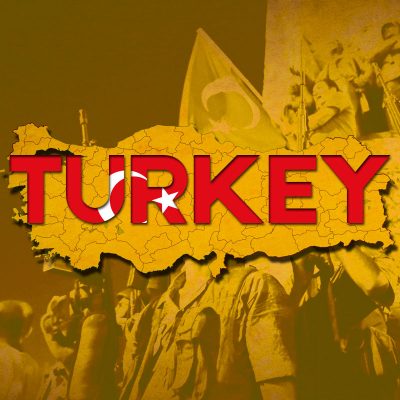DEAR FRIENDS. IF YOU LIKE THIS TYPE OF CONTENT, SUPPORT SOUTHFRONT WORK :
MONERO (XMR): 884Bz8UH63aYsjVdkfWfScRYWZGGNbjFL7pztqvWNSrtYT4reFSwyvkCj9KEGUtheHhhMUj87ciTBFyzoesrMJ4L1FvSoxL
BITCOIN: bc1qv7k70u2zynvem59u88ctdlaw7hc735d8xep9rq
BITCOIN CASH: qzjv8hrdvz6edu4gkzpnd4w6jc7zf296g5e9kkq4lx
ETH & TOKENS: 0x3cbded43efdaf0fc77b9c55f6fc9988fcc9b757d
OR CONTACT US : info@southfront.org
You can read this article in German: LINK
Turkey is steadily and almost surely moving towards military self-sufficiency. In addition to that it is moving towards one of the leading positions of unmanned systems producers.
The Bayraktar TB2 UAV is infamous at this point, with its affordable price and easy maneuverability and capability to carry out strikes in various environments.
Now, Turkey’s indigenous manufacturers compete to produce an unmanned ground vehicle (UGV).
Four unmanned ground vehicles are competing to enter service with Turkey’s military under the force’s medium-class UGV project.
Turkey’s largest defense company, Aselsan, is participating in the competition with its Aslan UGV, while Havelsan is pitching its Barkan; Best Group is offering its Fedai; and Elektroland Defence is proposing its Hancer.
All four feature Aselsan’s SARP remote-controlled weapon system.
According to a statement released by Turkey’s top defense procurement official, Ismail Demir, the indigenously produced UGVs have reached the final phase of the competition.
The four finalist UGVs carried out tests with their 7.62mm guns and the contest is expected to conclude with a final winner system in August 2021.
Demir described five categories on which the UGVs will be evaluated: general inspection, mobility, autonomy, firing and performance. Due to confidentiality no other specifications or information were provided.
There are, however, expectations that if more than one system is sufficiently good, there could be more than one winner, up to four, as there are that many finalists.
Havelsan first unveiled the Barkan in February to further the company’s “digital troop” concept, which aims for quicker, more effective battlefield technology. The UGV is equipped with a remote-controlled weapon system, electro-optical sensors and data link systems.
It can communicate with low-flying UAVs to carry out joint strikes.
Best Group’s Fedai weighs 400 kg, and can carry up to 400 kg of payload. It can reach a maximum speed of 10 kph. It also has an operational range of 1,000 meters within the line of sight of its operator and can operate up to 300 meters beyond the line of sight. It has a two-axis gyro-aided stabilized gun system that can carry a 7.62mm gun.
Hancer has a payload capacity of 500 kilograms and can operate for 6 hours after 3 hours of charging. The UGV can be controlled within 1,500 meters of its operator. Hancer’s moving pallet system provides an advantage in rough terrain, and it’s able to handle a vertical grade of 60 percent, a side-slope grade of 30 percent, and ditches that are 60 centimeters across. It can be equipped either with a 7.62mm remote weapon system or 40mm grenade launchers.
Finally, Aselsan is keeping its unit secret, but its specifications are likely somewhat similar to the other three contestants. Aselsan has also developed the Kaplan family of UGVs, which the Turkish military uses to neutralize explosive threats, and the company used the technology as a basis for the Aslan system. Aslan can be controlled and transmit data via satellite. For its part, the Kaplan can be fitted with a 7.62mm remote weapon system.
If reports and claims of Turkish UAV, UGV and even maritime drones all come into fruition, it could be that Israel may have some significant competition in the coming months and years.








In Unmanned Ground Vehicles the most advanced nation is by now or currently Russia.